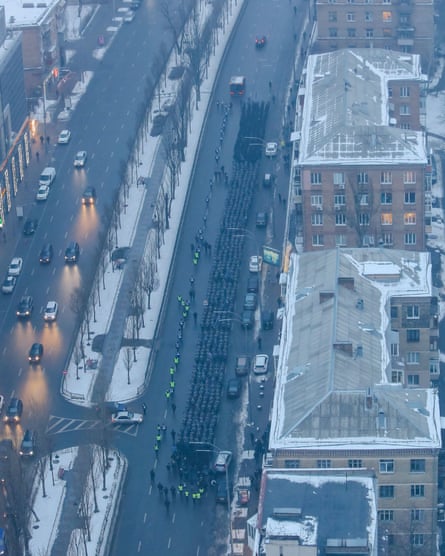Just past midnight in a snow-covered forest near Kiev, four men dressed in black with truncheons strapped to their waists listen carefully for the telltale buzzing of chainsaws that belong to illegal loggers. “The police in our country are ineffective, corrupt or drunk,” says Zhenya, one of the men. “That’s why we have to deal with this problem ourselves.”
These woodland vigilantes, all in their early to mid-twenties, are not your typical environmental activists. They are members of the National Militia, an ultranationalist organisation closely linked to Ukraine’s Azov movement, a far-right group with a military wing that contains openly neo-Nazi members, and its political spin-off, the National Corpus party.
“There’s nothing inherently wrong with national socialism as a political idea,” says Alexei, another militia member, as the men move stealthily through moonlit trees frosted with ice. “I don’t know why everyone always associates it immediately with concentration camps.”
Besides illegal logging, the National Militia says it aims to crack down on street crime, drug dealing and public alcoholism. “There are many of us. We are not scared to use force to establish a Ukrainian order,” it said in a recent statement.
On 29 January, hooded militia members turned up at a municipal council meeting in Cherkasy, in central Ukraine, and reportedly refused to let officials leave the building until they had approved the city’s long-delayed budget.
The National Militia says its members are all volunteers, and that expenses are covered by businesses and individuals sympathetic to its activities.
National Militia members include veterans of Ukraine’s four-year war against Russian-led separatists, as well as former football hooligans who took part in Ukraine’s 2013-14 revolution. Some are “straight edge” fitness fanatics who neither drink nor smoke. Many have no memory of life in the Soviet Union, having grown up in independent Ukraine, where trust in law enforcement agencies remains low despite recent police reforms.
“The police reforms were like pouring chocolate on shit,” said Alexei, after he and his fellow militia members had abandoned their unsuccessful search for illegal loggers. “It’s still shit, you know?”
Although the National Militia has been operating for a year, even conducting street patrols in towns and cities under Ukrainian government control, the group entered the spotlight late last month when about 600 of its members marched through central Kiev. Some wore camouflage gear, while others dressed in black with balaclavas covering their faces. This provocative show of strength culminated at a torch-illuminated fortress, where militia members swore oaths of allegiance to Andriy Biletsky, an ultranationalist MP who heads the National Corpus party.
“When the authorities are impotent and cannot solve issues of vital importance for society, then simple, ordinary people are forced to take responsibility upon themselves,” Biletsky told Ukrainian media.
Biletsky has toned down his rhetoric in recent years, but the former Azov battalion commander declared in 2010 that the Ukrainian nation’s mission was to “lead the white races of the world in a final crusade … against Semite-led Untermenschen [subhumans]”.

While Ukrainian law allows unarmed civilian organisations to assist law enforcement agencies, for many observers the ceremony in Kiev was reminiscent of 1930s Germany and kindled fears that Ukraine’s shaky democracy was in danger of being hijacked by an increasingly confident far right. National Corpus and other far-right parties are polling at less than 5%, but analysts say they could exploit Ukraine’s economic and social instability to boost their electoral chances.
“We are concerned about rising nationalism in Ukraine and the government’s seeming unwillingness to rein it in. Ukraine’s international donors and supporters should be very worried,” said Tanya Cooper, Ukraine researcher for Human Rights Watch.
National Militia officials says the concerns are unwarranted. “If the world is worried about the threat of Ukrainian neo-Nazism, I can assure you we are not neo-Nazis; we are simply people who want to change our country for the better,” said Ihor Vdovin, a spokesman for the National Militia. “We don’t want to establish some kind of white order.”
Vdovin said, however, that he could not answer for members of the militia who espouse white supremacist or neo-Nazis views.
“People got frightened when they saw how organised and disciplined the march in Kiev was,” said Stepan Holovko, a high-ranking member of National Corpus. “But why should we apologise for the fact that our people can carry out the tasks they’ve been set?”
Azov and National Corpus have been linked to Arsen Avakov, the Ukrainian interior minister who is seen as a possible successor to Petro Poroshenko, Ukraine’s unpopular president. Avakov has quelled speculation that the National Militia is his own private army, saying he would not allow “parallel structures” to challenge the authority of the police.
Vyacheslav Likhachev, head of the National Minority Rights Monitoring Group, suggested that the militia’s activities were aimed at making National Corpus stand out from rival ultranationalist parties ahead of next year’s parliamentary elections. “They are trying to prove that they have more hardcore activists they can mobilise on a street level.”
